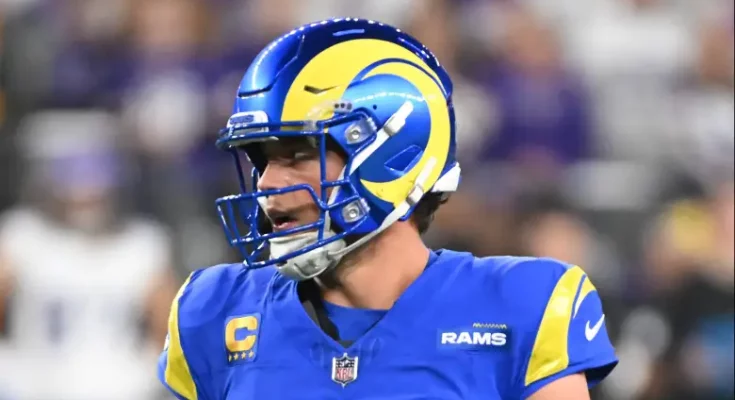When the Los Angeles Rams arrived at training camp this year, optimism hovered like a warm California breeze. After a disappointing and injury-riddled 2024 season, the Rams were hopeful for a resurgence. Central to those aspirations was the health and leadership of their franchise quarterback, Matthew Stafford. A proven veteran with a Super Bowl title under his belt, Stafford’s presence alone has long been considered the engine of Sean McVay’s offense. But as camp opened, a subtle yet notable shift in expectations emerged. Head coach Sean McVay, speaking to reporters, revealed that while the original plan was to have Stafford ready from day one, the team has decided to take a more cautious, “week-at-a-time” approach with the seasoned signal-caller. That declaration sent ripples through the league and raised eyebrows among fans and analysts alike.
For much of the offseason, the Rams had been quiet about Stafford’s exact recovery timeline. There were no glaring warning signs. No press releases hinting at setbacks. In fact, the messaging had remained optimistic. Stafford, now entering his 16th NFL season, had reportedly looked good in earlier offseason work and was spotted throwing passes and participating in team events. But beneath that surface-level positivity, there may have been lingering concerns. After all, Stafford has been through a gauntlet of injuries over the course of his career, ranging from back fractures and elbow issues to more recent soft tissue complications. At his age, and with the amount of punishment he has endured in the pocket over the years, any physical limitation—however minor—must be handled with vigilance.
McVay’s tone when addressing the media was neither panicked nor evasive. Instead, it was strategic. He described the decision to take it a week at a time as “the smart thing to do,” and in doing so, shifted the narrative from disappointment to prudence. There’s wisdom in that approach. Quarterbacks of Stafford’s caliber don’t need extensive reps in July to be sharp in September. His command of the Rams’ offense is unquestioned. What’s more critical is ensuring that Stafford is physically ready for the long haul, particularly the grind of a full 17-game schedule and, potentially, a postseason run. The Rams learned the hard way in 2022 and 2023 what happens when Stafford is unavailable or playing at less than 100 percent. The offense stagnates, the defense tires out from being overexposed, and the team collapses under the weight of its own limitations.
Stafford, ever the competitor, undoubtedly wants to be out there. That much is never in question. His toughness is well-documented. He famously played through injuries during his Detroit Lions days, including one occasion where he re-entered a game with a dislocated shoulder to throw a game-winning touchdown. But even the toughest players eventually learn to listen to their bodies—or, in this case, their medical staff and head coach. The Rams aren’t treating Stafford like a fragile porcelain figure. Rather, they’re acknowledging reality: he is a veteran asset whose contributions are too valuable to risk for the sake of a few extra snaps in July.
The Rams’ decision also reflects broader trends across the NFL. Veteran player maintenance has become a science. Teams are more cautious with training loads, and many top quarterbacks now receive “vet days” or scaled-back practice regimens. Tom Brady was legendary for managing his workload effectively late into his 40s. Aaron Rodgers, when healthy, also participated in reduced practice windows. Stafford is cut from a similar cloth. The key to maintaining peak performance in one’s mid-30s, especially at such a demanding position, is less about grinding through every drill and more about working smart. The Rams’ coaching and medical staff clearly understand this, and their actions reflect a long-term investment in Stafford’s viability—not just for Week 1, but for the duration of the campaign.
Another layer of this situation is the context of the Rams’ quarterback room. Behind Stafford, the team has been experimenting with young arms and backup options, but none with the pedigree or command to lead a playoff-caliber offense. That magnifies Stafford’s importance. While the Rams made some intriguing additions and continue to build a more balanced roster, the offense still runs through No. 9. The timing, the rhythm, the vertical passing game—it all hinges on Stafford being under center and in sync with his weapons. Sitting him out of early training camp reps might delay that chemistry slightly, but it also ensures that he’s available when it matters most.
From the players’ perspective, the team’s handling of Stafford sets a tone of professionalism and long-term thinking. Younger players get to see how a franchise quarterback is cared for, and it sends a message that the Rams are serious about competing smartly, not just grinding for the sake of optics. Cooper Kupp, Stafford’s trusted wide receiver, has also dealt with his share of injuries, and watching the team manage Stafford’s workload could create a ripple effect in how other key veterans are handled. McVay, always one of the league’s most forward-thinking minds, appears to be embracing a more sustainable approach this season. And if that means erring on the side of caution in July, it could pay dividends in December and January.
In the short term, fans might be disappointed not to see Stafford flinging bombs in early camp practices. Reporters may note the absence in scrimmages. But none of that will matter if Stafford takes the field in Week 1 healthy, composed, and dialed in. That’s the real goal. And if the Rams have learned anything from their rollercoaster campaigns of late, it’s that the presence of a healthy Stafford can make the difference between mediocrity and contention.
It’s also worth noting that Stafford himself is entering this season with something to prove. After capturing a Super Bowl ring in the 2021 season, injuries and inconsistency have clouded his narrative. Some have questioned whether he has enough gas left in the tank, or if his arm strength and mobility have declined. These are natural questions for any quarterback approaching 37, especially one with a history of physical toll. But if Stafford feels anything like the competitor he’s always been, this season offers a perfect opportunity for redemption. And if that means taking it slow for a few weeks in the summer, the payoff could be immense come autumn.
There is also a financial dimension to the Rams’ cautious approach. Stafford’s contract remains a significant commitment, both in cap terms and organizational expectations. While the Rams have undergone some financial reshuffling in recent years—shedding expensive contracts and seeking youth—they have held firm in their belief that Stafford gives them the best chance to win now. Managing that investment wisely means not rushing him back onto the field just to simulate competition or run plays that he already knows by heart. It means preserving the one player who, more than any other, can elevate the Rams’ offensive ceiling.
McVay’s phrasing—“the smart thing to do”—is telling. This is a team that has endured enough emotional and physical wear over the past few seasons to appreciate the value of a conservative approach. In the early years of McVay’s tenure, the Rams were one of the most innovative and high-octane teams in the league, and that energy carried them to multiple deep playoff runs. But recent seasons have tested their endurance, and the toll has been real. By slowing things down now with Stafford, they’re not waving a white flag—they’re recalibrating for a new kind of campaign, one that prizes health, depth, and savvy above all.
As training camp rolls on, all eyes will remain on Stafford’s status. Each week, McVay’s updates will be dissected for clues. Will Stafford participate in joint practices? Will he play in any preseason snaps? Or will he be held out entirely until Week 1? These questions will linger, but they’re the right kind of questions. They reflect a franchise that is learning from its past and not willing to compromise its future for the sake of tradition or pressure.
Stafford’s journey to this point has been marked by resilience. From the early struggles in Detroit to the glory of Los Angeles, his career has been one of quiet grit and undeniable talent. Now, as he stands at a pivotal moment—veteran leadership balanced against physical limitation—the Rams are choosing to trust the process. It’s not a flashy decision. It won’t dominate highlight reels. But in the long chess game of an NFL season, it might prove to be one of the most important moves the Rams make in 2025.
And for fans who want the best version of Stafford leading the huddle in crunch time, it’s a trade-off worth embracing. Because in the end, the only thing that matters isn’t how many practices Stafford logs in July—it’s how many games he wins when the real lights come on.



